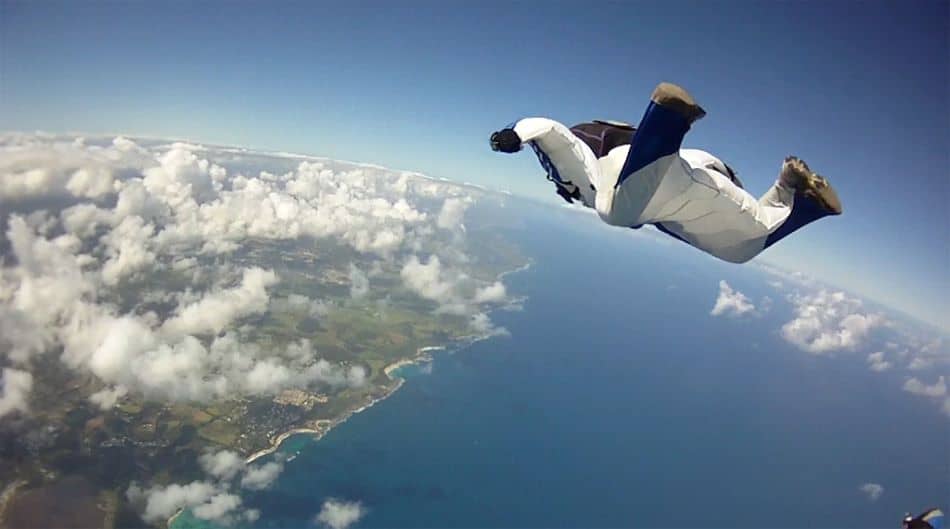
Wingsuit flying has become a popular extreme sport over the past decade, with many enthusiasts pushing the limits of what is possible. As with any extreme sport, many people wonder if they can pick it up. Part of this are specific requirements such as the weight limit for wingsuits.
There is no legal weight limit for wingsuit flying. The practical weight limit for wingsuits is 300 lbs (~135 kg) when landing in grass and 210 lbs (~95 kg) when landing on a more rigid surface. The weight limit is determined by the size and carrying capacity of the canopy.
In this article, I will delve deeper into these practical weight restrictions and the reasons why they are so important for the safety of wingsuit pilots.
The Role of Weight During Wingsuits Flights
As a general rule, the weight of wingsuit pilots plays a detrimental role in flight performance, landing safety, and wingsuit choice. Top athletes often go on a diet before a competition flight to optimize their flying speed, glide ratio, and maneuverability.
Weight Determines the Flight Performance of a Wingsuit Jump
The weight of wingsuit flyers has a significant impact on their flight performance, particularly during the freefall portion of the jump. Wingsuit flyers need to achieve a certain amount of speed to maintain their stability and control during the freefall, and the weight of the skydiver can affect the amount of speed they can achieve.
In general, the more wingsuit flyers weigh, the faster they will fall due to the force of gravity. In other words, the maximum speed before the air resistance balances the force of gravity is higher.
This also impacts the glide ratio of wingsuit flyers. The glide ratio describes how much horizontal distance can be covered in comparison to the vertical rate of descent. For example, a glide ratio of 3:1 means that the wingsuit pilot will fly 3 feet horizontally for every foot of vertical descent.
Because weight influences the glide ratio, top-performing athletes take close attention to their weight. Being able to fly longer distances plays a key role in setting new world records, and performing incredible stunts. For example, jumping in certain terrain (e.g., from mountains) might only be possible when achieving a certain glide ratio.
If you are interested in understanding how far wingsuit pilots can actually fly, I’ve written an article about this. It reveals the greatest distances ever traveled by wingsuit pilots – trust me, you won’t want to miss it!
Overall, it’s important for wingsuit pilots to understand how weight affects their jump characteristics and make appropriate adjustments to ensure safe and enjoyable wingsuit experiences.
Weight Influences the Landing Choice and Safety
During parachute descent, weight can also affect the descent rate and glide ratio of the canopy. A heavier skydiver will typically descend faster than a lighter one and may need a larger parachute to slow down their descent to a safe landing speed.
As a result, the maximum practical weight for wingsuit flyers is determined by their canopy size. The biggest canopy in the market is 310 square feet. A common rule of thumb says that the “weight of the wingsuit pilot” plus “100 square feet” should equal the “canopy size”.
To determine the canopy size it holds true that: Canopy size (in sqft) = Weight of pilot (in lbs) + 100 sqft
Reshuffling and solving this formula for the weight limit results in a practical weight limit of 210 lbs. This weight limit holds true for all grounds including rigid areas. If one lands in a designated drop zone the weight limit is increased up to 300 lbs because one will land in softer terrain.
However, this eliminates any margin of error during the canopy descent. If the wingsuit flyer of 300 lbs does not make it to the drop zone, he or she is prone to serious injuries during the landing process.
Weight and Body Shape Influence the Wingsuit and Comfort During the Flight
Weight often determines the body shape of a person. If you are overweight because you are very muscular and have a lean body shape, you do not have to worry about this. However, if you are overweight because you had one or two pizzas too many, your body shape will determine the wingsuit you can wear.
Simply put, the wingsuit might not fit if your belly is too large. Because wingsuit is still a niche sport, wingsuits are not available to fit all body forms. With more and more people moving into the sport, it will become more attractive and commercially interesting for wingsuit manufacturers to also design wingsuits for overweight people.
That being said, there are some wingsuit manufacturers which allow you to customize the suit. If you ask them for a special request, they might be able to fulfill it (even though it will come at additional costs).
Normally, you could just take a wingsuit that is much larger in height to compensate for the increased need for belly space. However, this is not a viable option because one will have less control over the wings. Moreover, the wings might not inflate properly if the wingsuit is too loose.
The overall wearing comfort of the wingsuit will also be affected. Wingsuits that are too tight can be uncomfortable to wear, especially with the harness and rigging system on.
I actually know people who lost quite some weight in order to fit wingsuits and be able to fly. If you are one of those, keep up the work!
Is There a Minimum Weight Limit For Wingsuit?
There is no minimum weight for wingsuit fyling. As a general requirement, wingsuit flyers need to be at least 18 years old. When being 18 years old, people usually reach a certain weight, thereby putting a minim weight inherently.
What Is the Weight Limit for Windtunnel Wingsuits?
On average, the weight limit for wind tunnels is 250-260 lbs (113-120 kg), depending on the design of the tunnel. There are some specialized wind tunnel centers that allow for an upper weight limit of up to 300 lbs (~135 kg).
What Is the Minimum and Maximum Height For Wingsuit Flying?
On average, current wingsuits are designed to fit a body size between 5.5-6.5 ft (165-200 cm). However, some wingsuit manufacturers offer customization services to allow for greater and smaller body sizes. This will come at additional costs.
Do I Need to Be Strong to Fly a Wingsuit?
As a general rule, physical strength is not a requirement for wingsuit flying. While wingsuit flying is physically demanding, it is more about body control, technique, and mental focus than brute strength. Wingsuit flyers, however, will need some strength to carry the equipment around on the ground.
If you’re wondering whether wingsuit flying is difficult to learn and master, my latest post has all the answers. I dive into the intricacies of this adrenaline-fueled activity, exploring the surprising skills and experience required to succeed in the world of wingsuit flying.
Enjoy your free fall!
Photo Credits
Richard Schneider from Los Angeles, CC BY 2.0 https://creativecommons.org/licenses/by/2.0, via Wikimedia Commons, resized

